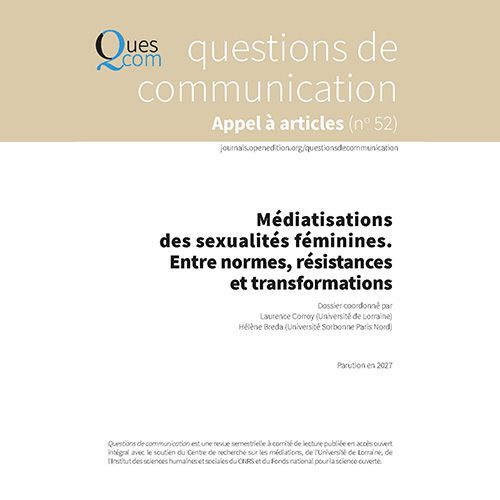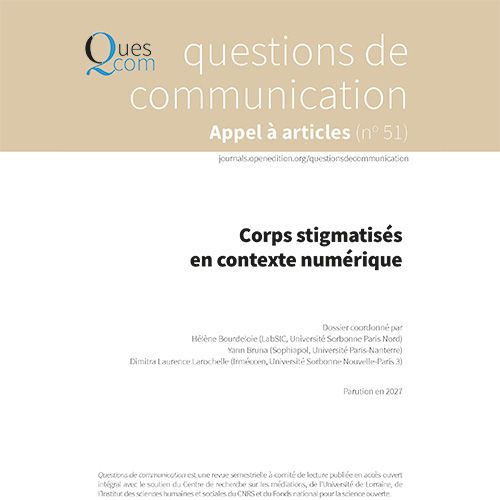International Conference on (Cyber)bullying

Call for proposals
Language: English
(Appel au format PDF disponible en français en bas de page)
Deadline for proposals: 15 April 2022 23h59 GMT
THEME
Bullying – or harassment – can be defined as a repetitive and intentional hurting of one person by another or by a group, in a situation of power imbalance (the bully has physical and/or psychological control over his/her target or mistreats him/her with a group of followers that he/she has gathered around him/her) (Olweus, 1999). Bullying can have multiple consequences, with both short and longterm effects: anxiety, loss of self-confidence, sleep disorder, depressive disorder, social phobia, etc. Bullying is a phenomenon that occurs in many social contexts: high school (Smith, Sharp, 2000; Catheline, 2015; Roberge, Beaudouin, 2016); university (Hamel, 2008), workplace (Hirigoyen, 2017); family – bullying among siblings – (Tippet, Wolke, 2014); domestic sphere (Hirigoyen, 2003). Street harassment can also be included (Gayet-Viaud, 2021). Bullying can take many forms: verbal (insult, mockery), psychological or moral abuse (denigration, humiliation, threats, rumors), physical (pushing, hitting) or sexual violence (touching, forced kissing, sexual advances). With the emergence of the Web 2.0 and smartphones in the mid-2000, new forms of bullying and violence have appeared : sending insulting or threatening text messages, sending explicit or sexually suggestive emails, happy slapping, identity theft, revenge porn… Several studies – some of which were conducted with an intersectional approach (Stoll, Block, 2015; Angoff, Barhart, 2021) – converge on the fact that this type of violence is oftentimes gender-based, and strongly rooted in gender stereotypes and sexism. For example, among teenagers, girls are twice as likely to be victims of cyberbullying as boys, and young LGBTQIA+ people are four times as likely (Couchot-Schiex et al., 2017; Felmee, Faris, 2016 ; Hinduja, Patchin, 2020). In addition, racism, fatphobia and the stigmatization of students with disabilities also play a significant role in both school bullying and cyberbullying (Sentenac et al., 2016; Debarbieux et al., 2018).
There is no consensus on the definition of cyberbullying. Some scholars define it as attacks perpetrated through digital tools, while others define it similarly to bullying (Vandebosch, Van Cleemput, 2008; Smith et al., 2008). However, while the imbalance of power is almost always present in a digital context (bullies can act anonymously or pseudonymously; content can spread virally involving many others as witnesses), the repetitive nature and the intention to harm are more difficult to grasp. Repetition can come from the fragmentation of actions (each like or comment participates in the dissemination of content) or from the permanence of digital traces (compromising content can resurface months later), but the intention to harm is not always indisputable, as one can “like” or “retweet” out of habit, inadvertently, under the influence of emotion or in order to publish content to entertain others and gain popularity (boyd, 2015) without anticipating the online violence that can result (Stassin, 2021). Furthermore, the emotional intensity attached to content can facilitate its online dissemination, while digital mediation can also lead to the distancing of emotions (Quemener, 2018; Alloing, Pierre, 2020).
Many studies have been dedicated to examining the link between school bullying and cyberbullying between students (Li, 2007; Dooley et al. 2009; Pyżalski, 2012), providing characterization of cyberbullying dynamics (Willard, 2007; Blaya, 2013) or focusing on the actors and devices involved in their prevention (Blaya, 2015; Dilmaç, Kocadal, 2019). Other studies have pointed out that this peer violence continues at the university (Faucher et al., 2014), but also at the workplace (Dupré, 2018) where different forms of digital incivilities are observed which, when repeated, have deleterious effects (Carayol, Laborde, 2021). Finally, others have focused on the private and domestic sphere, where digital technology has become a tool for control, domination and humiliation, within a couple or after a divorce or separation (Fernet et al.; 2019). For example, one can cite the use of revenge porn by men as retribution against their partner or ex-partner after a sentimental rupture or an infidelity: in a “name or shame” strategy to affect their reputation, they humiliate by publishing private and identifying content online without their consent (Hall, Hearn, 2019).
Humiliating or compromising messages can be sent to a single person by dozens or hundreds of people. This phenomenon, called “flaming”, is now recognized by the French Law of 3 August 2018 as “pack cyberbullying” and stipulates that anyone participating in this kind of action, even by a single like or comment, can now be convicted. These “digital raids”, which generally target women (famous or not), LGBTQIA+ people or other minorities, or human rights advocates (Corroy, Jehel, 2019), feminist or anti-racist activists (Bibié, Goudet, 2018), can be compared to online hate speech (Monnier, Seoane, 2019). Indeed, the latter is based on the alleged feeling of hatred towards a minority group – sexual or gender minority, ethnic minority, people with disabilities – (Pyżalski, 2022) and/or based on the instigation of hatred by inciting violence or reinforcing stigmas.
For this conference, unpublished, innovative papers focusing on – but not limited to – the following topics are welcome :
1. Theoretical approaches to online violence and cyberbullying
- Definition, characterization and conceptualization of cyberbullying (school cyberbullying, cyberbullying at the workplace), of digital incivilities or hate speech;
- Links between “bullying” and “cyberbullying”, “bullies” and “cyberbullies”;
- Exploration of the terminology: “cyberbullying” versus “cybermobbing”, or versus “cyberharassment”.
2. The role of emotions and feelings
- Affective dimension of online violence, bullying, harassment or hate;
- The role played by emotions in bullying or cyberbullying (among bullies, witnesses or bullied, but also among people involved in the fight against bullying or even among researchers studying this violence);
- The place taken by emotions in discourses about cyberbullying (for example in the media);
- The socio-technical specificities of platforms and the way in which the affective intensity of contents related to violence can facilitate their circulation and the intensity of the reactions they generate;
- The way in which technical mediation can contribute to a distancing of emotions and empathy.
3. Intersectional approaches
- Power dynamics in online violence and hate speech;
- The role played by victims or aggressors belonging to a minority or to a privileged group in the dynamics of bullying/harassment ;
- Hate speech against feminist activists, human right advocates and intersectional activists;
- The emergence of support or mutual aid groups induced by intersectional approaches.
4. Prevention of cyberbullying and online violence
- Actors and tools involved;
- Educational initiatives and the role played by school, teachers, etc.;
- Digital literacy and digital citizenship;
- Psychosocial skills development;
- Hashtag activism (#metoo, #stopbullying, #stopbodyshaming);
- Empowering youth to combat bullying and cyberbullying;
- Legal responses to cyberbullying;
- The responsibilities of social media companies in the regulation of cyberbullying and hate speech.
Submission guidelines
Proposals should be sent to the following address : colloquecyberharcelement@protonmail.com
by 15 April 2022
In order to guarantee the double-blind evaluation process, please send :
- An anonymous document containing your presentation proposal: maximum length of 6000 characters (2 pages), with a title, the chosen topic from the conference call, an abstract of the presentation including the research question, a brief review of the literature and/or theoretical perspectives, elements of methodology and essential bibliographic references;
- A second document specifying the title of your paper, your name, your first name and your institutional affiliation.
Notifications of acceptance will be sent between 30 June and 15 July 2022. The issuing of a collective publication is planned at a later date, following the conference.
The registration fee is €50 for permanent faculty members (professors). The conference is free for students, PHD students and non-permanent faculty members (lecturers, adjuncts).
ORGANIZER
Contact :
- Delias Lucie: lucie.delias@gmail.com
- Lallet Mélanie: melanie.lallet@yahoo.fr
- Stassin Bérengère: berengere.stassin@univ-lorraine.fr
Steering committee
- Belhadi Morgane, Crem, Irméccen, Université Sorbonne Nouvelle
- Delias Lucie, LERASS-Céric, Université Paul Valéry-Montpellier 3
- Lallet Mélanie, CHUS-Arènes, Université Catholique de l’Ouest
- Lechenaut Émilie, Crem, Université de Lorraine
- Philippe Sandrine, Crem, Université de Lorraine
- Promonet Aurore, Crem, Université de Lorraine
- Pyżalski Jacek, Adam Mickiewicz University, Poznań (Pologne)
- Schneider Anne-Cécile, IUT Nancy-Charlemagne, Université de Lorraine
- Stassin Bérengère, Crem, Université de Lorraine
- Walter Natalia, Adam Mickiewicz University, Poznań (Pologne)
Scientific committee
- Alloing Camille, LabFluens, UQAM (Canada)
- Balleys Claire, Medi@lab, Université de Genève (Suisse)
- Blocquaux Stéphane, LIRFE-LAMPA, Université Catholique de l’Ouest (France)
- Carayol Valérie, MICA, Université Bordeaux Montaigne (France)
- Carlino Vincent, CHUS-Crem, Université Catholique de l’Ouest (France)
- Caesens Gaëtane, PSP-IPSY, Université Catholique de Louvain (Belgique)
- Cordier Anne, Crem, Université de Lorraine (France)
- Corroy Laurence, Crem, Université de Lorraine (France)
- Cousin Clément, CREDO-IODE, Université Catholique de l’Ouest (France)
- Dalibert Marion, GERiiCO, Université de Lille (France)
- Déage Margot, CERTOP, Université Toulouse II Jean Jaurès (France)
- Frachiolla Béatrice, Crem, Université de Lorraine (France)
- Galand Benoît, GRES, Université Catholique de Louvain (Belgique)
- Gevrey Vincent, LIRFE-LACES, Université Catholique de l’Ouest (France)
- Hamiche Sandra, Irméccen, Université Sorbonne Nouvelle (France)
- Labelle Sarah, LERASS-Céric, Université Paul Valéry-Montpellier 3 (France)
- Laborde Aurélie, MICA, Université Bordeaux Montaigne (France)
- Lapeyroux Natacha, FNRS, Université Libre de Bruxelles (Belgique)
- Larochelle Laurence, Irméccen, Université Sorbonne Nouvelle (France)
- Ledegen Gudrun, PREFICS, Université Rennes 2 (France)
- Mésangeau Julien, Irméccen, Université Sorbonne Nouvelle (France)
- Mathys Cécile, CRI’J, Université de Liège (Belgique)
- Millette Mélanie, LabCMO, UQAM (Canada)
- Olivesi Aurélie, Elico, Université de Lyon 1 (France)
- Poleszak Wieslaw, University of Economics and Innovation in Lublin (Pologne)
- Pugnière-Saavedra Frédéric, PREFICS, Université de Bretagne Sud (France)
- Pyżalski Jacek, Université de Poznań (Pologne)
- Theviot Anaïs, CHUS-Arènes, Université Catholique de l’Ouest (France)
- Walter Natalia, Adam Mickiewicz University, Poznań (Pologne)
Bibliography
- Alloing, Camille, Pierre, Julien (2020). « Le tournant affectif des recherches en communication numérique : présentatio ». Communiquer, n° 28, 2020, p. 1-17.
- Angoff, Harrisson, D., Barnhart, Wesley, R. (2021). « Bullying and Cyberbullying among LGBQ and Heterosexual Youth from an Intersectional Perspective : Findings from the 2017 National Youth Risk Behavior Survey ». Journal of School Violence, 20(3), p. 274-286. https://doi.org/10.1080/15388220.2021.1879099
- Dooley Julian, Pyżalski Jacek, Cross Donna (2009). « Cyberbullying Versus Face-to-Face Bullying. A Theoretical and Conceptual Review », Journal of Psychology, Vol. 217, n° 4, p. 182-188. 10.1027/0044-3409.217.4.182.
- Bibié, Laetitia, Goudet, Laura (2018). « Discours militants en ligne : Que disent les trolls? », Colloque international Réseaux sociaux, traces numériques et communication électronique, IUT du Havre. Idées Le Havre (CNRS, Université Le Havre Normandie), Jun 2018, Le Havre, France.
- Blaya, Catherine (2013). Les ados dans le cyberespace : Prises de risque et cyberviolence. Bruxelles : De Boeck, 235 p.
- Blaya, Catherine (2015). « Cyberviolence : état de la question », dans Debarbieux, Éric (dir.). L’école face à la violence. Décrire, expliquer, agir. Malakoff : Armand Colin, p. 52-64
- boyd, danah (2015). It's Complicated: The Social Lives of Networked Teens, New Haven, Yale University Press, 281 p.
- Catheline, Nicole (2015). Le harcèlement scolaire. Paris : PUF, 128 p
- Carayol, Valérie, Laborde, Aurélie (2021). Incivilités numériques. Quand les pratiques numériques reconfigurent les formes de civilité au travail. Bruxelles, De Boeck, 160 p
- Corroy, Laurence, Jehel, Sophie (2019). « Le numérique a-t-il enflammé les violences contre les défenseurs des droits humains ? ». Revue française des sciences de l’information et de la communication, n° 18. https://doi.org/10.4000/rfsic.8401
- Couchot-Schiex, Sigolène, Moignard, Benjamin (dir.), Richard, Gabrielle, Observatoire Universitaire International d’Éducation et de Prévention (2016). Cybersexisme : une étude sociologique dans des établissements scolaires franciliens [Rapport de l’étude commandée par le Centre francilien pour l’égalité femmes-hommes], 84 p. Université Paris Est Créteil : Centre Hubertine Auclert. [en ligne]. Disponible sur : https://www.centre-hubertine-auclert.fr/sites/default/files/fichiers/etudecybersexisme-web.pdf
- Debarbieux, É., Alessandrin, A., Dagorn, J. et Gaillard, O. (2018). Les violences sexistes à l’école. Une oppression viriliste. Rapport de l'Observatoire européen de la violence à l'École, 131 p. Disponible sur : http://prevenance-asso.fr/wp-content/uploads/2018/06/Les-violences-sexistes- %C3%A0-l%E2%80%99%C3%A9cole-une-oppression-viriliste.pdf
- Dilmaç, Julie, A., Kocadal, Özker (2019). « Prévenir le cyberharcèlement en France et au RoyaumeUni : une tâche impossible ? » Déviance et Société, n° 43, p. 389-419. https://doi.org/10.3917/ds.433.0389
- Dorlin, Elsa (2009). Sexe, race, classe, pour une épistémologie de la domination, Paris, Presses Universitaires de France
- Dupré D. (2018) « Cyber harcèlement au travail : revue de la littérature anglophone ». Communication et organisation, n° 54, p. 171-188.
- Faucher, Chantal, Jackson, Margaret, Cassidy, Wanda (2014). « Cyberbullying among University Students: Gendered Experiences, Impacts, and Perspectives ». Education Research International. https://doi.org/10.1155/2014/698545
- Felmee, Diane, Faris, Robert (2016). « Toxic Ties : Networks of Friendship, Dating, and Cyber Vicitmization », Social Psychology Quarterly, vol. 79, n° 3, p. 243-262. DOI: 10.1177/0190272516656585.
- Fernet, Mylène, Lapierre Andréanne, Hebert Martine, Cousineau Marie-Marthe (2019). « A Systematic Review of Literature on Cyber Intimate Partner Victimization in Adolescent Girls and Women ». Computers in Human Behavior, vol. 100, 11-25. DOI:10.1016/j.chb.2019.06.005
- Gayet-Viaud, Carole (2021). « Le harcèlement de rue et la thèse du continuum des violences ». Déviance et Société, Vol. 45, n° 1, p. 59-90. https://doi.org/10.3917/ds.451.0057
- Hall Matthew, Hearn Jeff (2019). « Revenge pornography and manhood acts: a discourse analysis of perpetrators’ accounts », Journal of Gender Studies, Vol. 28, n° 2, p. 158-170. DOI : https://doi.org/10.1080/09589236.2017.1417117
- Hamel, Christelle (2008). « Le traitement du harcèlement sexuel et des discriminations à l'université: La France n'est toujours pas en conformité avec le droit européen ! ». Mouvements, 55-56, p. 34- 45. https://doi.org/10.3917/mouv.055.0034
- Hinduja, Sameer, Patchin, Justin (2020). Bullying, Cyberbullying, and Sexual Orientation/Gender Identity. Cyberbullying Research Center (cyberbullying.org). https://cyberbullying.org/bullyingcyberbullying-sexual-orientation-lgbtq.pdf
- Hirigoyen, Marie-France (2003). Le harcèlement moral: La violence perverse au quotidien. Paris : La Découverte, 216 p.
- Hirigoyen, Marie-France (2017). Le harcèlement moral au travail. Paris : Presses Universitaires de France, 128 p.
- Li, Qing (2007). « New bottle but old wine: A research of cyberbullying in schools », Journal Computers in Human Behavior, vol. 23, n° 4, p. 1777-1791. DOI: https://doi.org/10.1016/j.chb.2005.10.005.
- Monnier, Angeliki, Seoane, Annabelle (2019). « Discours de haine sur l’internet », Publictionnaire. Dictionnaire encyclopédique et critique des publics. Mis en ligne le 12 juin. Accès : http://publictionnaire.huma-num.fr/notice/discours-de-haine-sur-linternet
- Olweus, Dan (1999). Violences entre élèves, harcèlements et brutalités. Les faits, les solutions. Issyles-Moulineaux : ESF Éditeur, 108 p.
- Pyżalski, Jacek. (2022 – in press) « Electronic Aggression » in : Z. Yan (ed.). The Cambridge Handbook of Cyber Behavior. New York: Cambridge University Press.
- Pyżalski, Jacek (2012). « From cyberbullying to electronic aggression : Typology of the phenomenon ». Emotional and Behavioural Difficulties, Vol. 17, n° 3-4, p. 305-317. https://doi.org/10.1080/13632752.2012.704319
- Quemerer, Nelly. « « Vous voulez réagir ? ». L’étude des controverses médiatiques au prisme des intensités affectives », Questions de communication, n° 33, 2018, p. 23-41.
- Roberge, Ginette, Beaudoin, Huguette (2016). « Contrer l’intimidation scolaire : Portrait des plans d’action pancanadiens ». McGill Journal of Education / Revue des sciences de l’éducation de McGill, Vol. 51, n° 1, p. 475-493. https://doi.org/10.7202/1037355ar
- Sentenac, Mariane, Pacoricona, Dibia, Godeau, Emmanuelle (2016). « Comment les élèves handicapés perçoivent-ils le collège ? Un climat scolaire inclusif pour une école plus inclusive. » Agora débats/jeunesses, hors-série, n° 4, p. 79-94.
- Smith, Peter, Shu, Shu (2000). « What Good Schools can Do About Bullying : Findings from a Survey in English Schools After a Decade of Research and Action ». Childhood, Vol. 7, n° 2, p.193-212. https://doi.org/10.1177/0907568200007002005
- Stassin Bérengère. « Cyberharcèlement » Publictionnaire. Dictionnaire encyclopédique et critique des publics. Mis en ligne le 02 mars 2021. Dernière modification le 21 septembre 2021. Accès : http://publictionnaire.huma-num.fr/notice/cyberharcelement
- Stoll, Laurie, C., Block, Ray (2015). « Intersectionality and cyberbullying : A study of cybervictimization in a Midwestern high school ». Computers in Human Behavior, 52, p. 387-397. https://doi.org/10.1016/j.chb.2015.06.010
- Tippett, N., Wolke, D. (2014). « Aggression between siblings: Associations with the home environment and peer bullying ». Aggressive Behavior, Vol. 41, p. 14-24. http://dx.doi.org/10.1002/ab.21557
- Vandebosch, Heidi, Van Cleemput Katrien (2008). « Defining Cyberbullying: A Qualitative Research into the Perceptions of Respondents », Cyberpsychology and Behavior, Vol. 11, n° 4, p. 499-503. DOI : https://doi.org/10.1177/1461444809341263
- Willard, Nancy (2007). Cyberbullying and Cyberthreats: Responding to the Challenge of Online Social Aggression, Threats, and Distress. Champaign: Research Press, 320 p.




